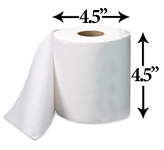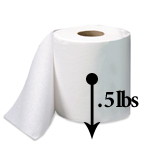
 |
 |
 |
 |
 |
Toilet paper is intended to provide a means of cleaning the user's anal and/or genital region typically after defecation or urination. It has several other secondary uses such as nose care, removing makeup, cleaning mirrors, covering toilet seats, and cleaning glasses (Charmin.com).
Toilet paper is intended to be used by everyone with a standard digestive system (including a colon and anus). Some individuals such as those with necrotizing enterocolitis (an acute inflammatory disease of the bowel), imperforate anus (absence of anal opening) or Hirschsprung's Disease (a condition in which the nerves controlling bowel function are abnormal) would be using colostomy bags and would probably not benefit from toilet paper. They still may use it for its secondary uses.
 |
 |
The standard size of one sheet of toilet paper is 4.5" x 4.5". The diameter of the roll varies, but is usually around 4.5". The standard number of sheets in a roll is 1000 for one-ply and 500 for two ply. Some brands of toilet paper have less sheets and are of a smaller size sheet (and those sheets used in the vatican are holy sheets.) The average roll weighs approximately 227 grams (.5lbs) including the cardboard tube.
One-ply means a single layer of tissue and two-ply consists of two layers of tissue. Two-ply is not necessarily twice the thickness. In fact, one-ply is made of a 13# thickness paper versus two-ply which consists of two layers of 10# thickness paper. Oddly, people use about the same amount of sheets (when comparing one-ply and two-ply), but less paper is therefore used with one-ply. When comparing prices of one-ply (1000 sheets) and two-ply (500 sheets), one-ply is slightly more expensive but on average lasts twice as long. One-ply will also tend to break down faster in a septic system.
Tissue softness is an important design quality and this is usually achieved
with a process called "creping." During the drying process,
the toilet paper sheet is adhered to one large steel cylinder to dry and
is then scraped (or "creped" off) by a metal blade. This process
imparts flexibility and stretch into the sheet, while lowering the strength
and density, resulting in soft tissue products. (Georgia-Pacific)
The average roll of toilet paper, in an average household, in the most-used bathroom of the house lasts approximately five days. Consumers use approximately 8.6 sheets of paper per toilet use. This is a total of 57 sheets per day and 20,805 sheets per year (42 rolls of two-ply or 21 rolls of one-ply). 68% of consumers hang toilet paper with the first sheet going over the roll, while 25% prefer to hang the first sheet under the roll.(Charmin)
A survey administered to a sample population of 106 people by a Steve Silverman, a science teacher in Albany, shows the following wiping statistics:
44% wipe from front to back from behind their backs.
60% look at the paper after they wipe.
50% say that they have wiped with leaves.
8% have wiped with their hands.
2% have wiped with money.
Silverman's survey shows that 44% of people asked wipe from front to back. A registered nurse and acquaintance claims that wiping from the back to front can be more sanitary for men. The geometry of the region creates a natural collection area when wiping to the front. Women, however, should always wipe from front to back to avoid infection.
 |
 |
The following are some interesting percentages on toilet paper use taken from a Kimberly Clark survey in July 5th, 2000. It shows that more men "fold" and more women "wad".
40% fold or stack, 40% wad or crumple, 20% wrap it around their hand.
52% (Men) & 38% (Women) are "folders"
38% (Men) & 52% (Women) are "wadders"
6% (Men) & 6% (Women) have no preference
4% (Men) & 3% (Women) don't know